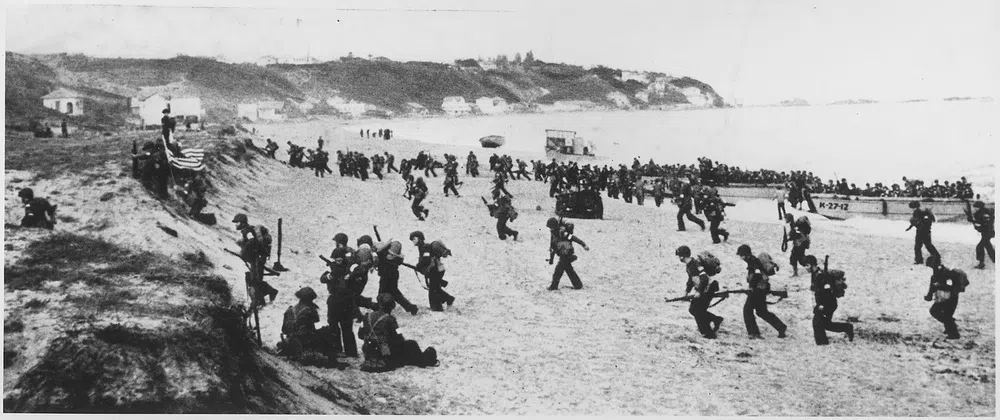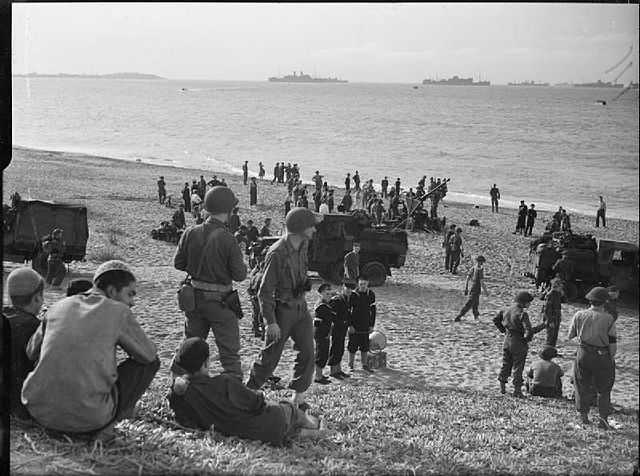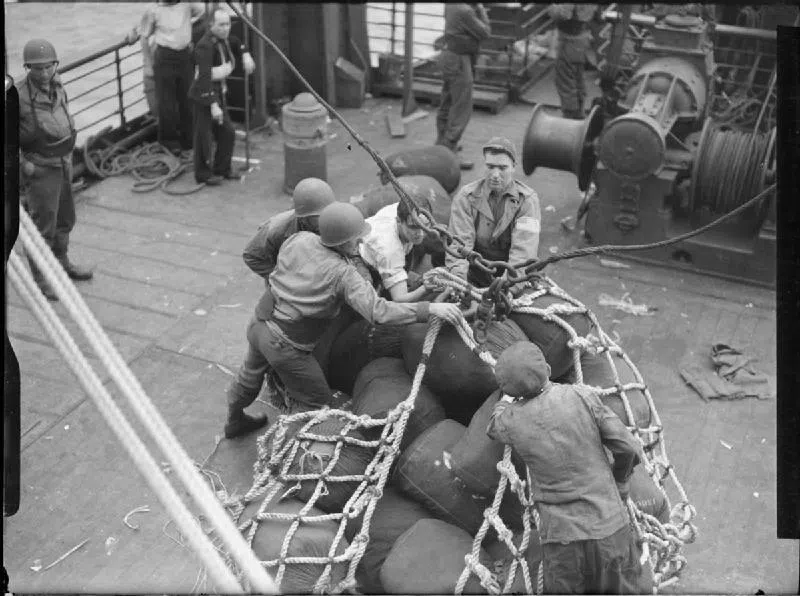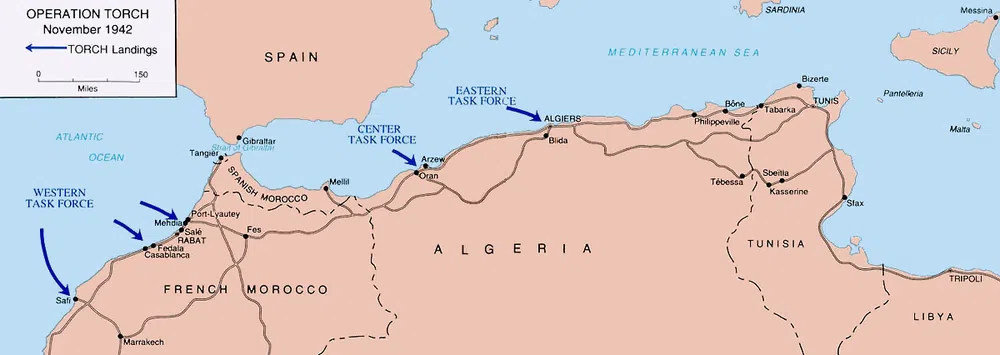Operation Torch was a brief, one-week-long Anglo-American-led invasion of North Africa—then partly controlled by the collaborationist Vichy France—in November 1942. The goals of this operation were to allow the Americans to engage their opponents in a limited way, to use North Africa for further operations against the Axis powers, and to gain access to the Mediterranean Sea.

Fig. 1 - U.S. troops land on the beach near Algiers, Operation Torch, November 8, 1942.
Operation Torch: Summary
Operation Torch was the combined effort of the U.S. and British armed forces and their allies such as Free France. Torch took place during November 8-16, 1942, in North Africa: the French colonies Algeria and Morocco officially aligned with Nazi Germany at that time.
Did you know?
German-occupied France was called collaborationist Vichy France or the French State. The French resistance to the Nazis was known as Free France. Charles de Gaulle, the leader of Free France, became the President of France after the war.
This operation was a compromise instead of immediately opening a full-scale second front in Western Europe, which did not happen until mid-1944. Overall, Operation Torch was a success for a number of reasons, including:
- The Allied forces successfully invaded Morocco and Algeria;
- The French North African command signed an armistice with the U.S. forces and surrendered;
- This was the first serious battle for the American forces outside the Pacific on a limited scale.
An armistice is a formal truce between the opposing sides in a war that puts an end to further armed hostilities.
Operation Torch: WWII
Operation Torch was an important, early joint Anglo-American operation in the first half of World War II.
Operation Torch: Background
World War II (1939-1945) began on September 1, 1939, when Nazi Germany invaded Poland—with Britain and France declaring war on Germany two days later. The United States joined the war two years into it—after Japan's Pearl Harbor strikes in December 1941.
In June of the same year, Nazi Germany invaded the Soviet Union (USSR). Since then, the USSR had been singlehandedly fighting the Wehrmacht, the German troops, on the Eastern front in continental Europe. At this time, the Soviet Union received support in other ways.
One important way of aiding the Soviet Union was through Lend-Lease, an American program established in 1941 to help the Allies. Lend-Lease replaced an earlier variant—cash-and-carry—when Britain began to run out of money. Lend-Lease included everything from materiel (military equipment) to oil and food.
Establishing a second front in continental Europe was a necessity. It was not until June 6, 1944, that the latter occurred through the Normandy Landings. However, there were other important Anglo-American-led operations that fought the Axis powers elsewhere. One such operation was Operation Torch.
The Grand Alliance
The Soviet leader Joseph Stalin, the British Prime Minister Winston Churchill, and the American President Franklin D. Roosevelt led the Grand Alliance during World War II. After Roosevelt's death in April 1945, President Harry Truman took over. The Grand Alliance led the Allied effort against the Axis powers headed by Germany, Italy, and Japan.
The Allied leaders stayed in communication and periodically met:
During the first half of the war, one key question was about opening the second front in continental Europe.
Did you know?
The Soviet Union was responsible for up to 80% of the total Nazi-German losses in World War II. At the same time, the Soviet Union lost an estimated 27 million lives in this war.
The Soviet leadership insisted upon Anglo-American help in this regard. However, Britain and the U.S. exercised caution and delayed launching a major operation until mid-1944.
- The British, led by Winston Churchill, opposed opening a second front in Western Europe in 1942. The Americans, specifically the Chief of Staff of the U.S. Army George C. Marshall, disagreed with Churchill’s policy of leaving the Red Army to fight on its own and believed it would be one of the greatest military mistakes in history.
- Marshall proposed a compromise for 1942:
- 1) Improve the U.S. strength (ground, navy, and air) in Britain;
- 2) Emergency landing in France in September 1942 (Operation Sledgehammer);
- 3) Plan to launch the Western front at a later date.
- Churchill’s counterproposal was the invasion of French North Africa because it would be safer than invading the coast of France. It was this operation that came to be known as Torch.
Operation Torch: Key Events
The Americans led Operation Torch with Marshall assigning Major General Dwight D. Eisenhower in July 1942 as its commander. Eisenhower also led the American forces in Europe.
Did you know?
Major General Dwight D. Eisenhower later served as the 34th President of the United States from 1953-1961.
The landing sites and dates were a subject of debate. Ultimately, in August 1942, the Anglo-Americans decided upon November with multiple Mediterranean landing sites no further than Algiers, the capital of Algeria, in the eastward direction.
Robert Murphy, the U.S. diplomatic representative in North Africa believed that he could gain support by discreetly persuading French officers sympathetic to the Allied forces. General Charles Mast was a particularly important member of the secret Allied sympathizers. His cooperation came from Operation Flagpole, and he suggested that Allied forces' senior representative should travel to talk with the French Commander in Chief Alphonse Juin. A rendezvous took place at a secret coastal villa west of Algiers. Clark advised Mast that a large-scale invasion of Allied forces into North Africa was incoming but did not specify the times or landing sites. Clark excluded this information to increase secrecy for national security purposes. However, this move also rendered the sympathetic French forces unable to help with the initial invasion.
The parties involved in the clandestine meeting to establish cooperation with the French allied sympathizers were transported to the isolated villa via submarine. This was to ensure the secrecy and security of those involved.
On the Atlantic coast, the main landing was made at Fedala (Mohammedia), northeast of Casablanca. These amphibious landings by the U.S. forces came as a surprise to both the French occupying forces as well as those whom the Allied forces had secretly recruited. This tactic decreased the resistance to the invading Anglo-Americans but also limited the assistance from the secret allies within the occupying French.

Fig. 2 - British and American forces on a beach near Algiers, November 1942.
During the first few days of the invasion, the outlook was not positive. The latter changed, however, when on November 10th when General Charles-Auguste Nogues, head commander of French forces in Morocco, heard that the French command in Algiers had issued an order to stop fighting.
- Francios Darlan was the Commander-in-Chief of the armed forces of the Nazi-aligned Vichy France. However, he also sought to double-cross France's collaborationist leader Philippe Pétain. The Allies offered Darlan the status of the Governor General of French North Africa. Darlan agreed. His subordinates lessened their active resistance to the invading forces pending an armistice arrangement in the morning.
On November 10th the fighting came to an end via an armistice between French authorities in Morocco and the Americans. The French troops had surrendered at Oran after an attack by a British battleship.
Countries Involved in Operation Torch
Several countries were involved in Operation Torch.
| Allies | Axis |
- Britain
- United States
- Canada
- Free France
- Australia
- India
- Netherlands
| - Vichy France
- Germany
- Italy
- Algeria (French colony)
- Morocco (French colony)
|

Fig. 3 - The Royal Navy during Operation Torch, November 1942.
Operation Torch: Map
The Allied forces landed on the coast of Algeria as well as Morocco which were French colonies at that time.

Fig. 4 - Operation Torch landing sites, November 1942.
The End of Operation Torch
Operation Torch came to an end with the order for the French forces to cease resisting the invasion by Darlan. On November 10th, the armistice was signed, and the French forces in North Africa surrendered. However, the Germans would move their air fighters into Tunisia and invade the previously unoccupied southern France immediately following the armistice between the French and the Americans.
Operation Torch: Impact
There were several consequences of Operation Torch, including:
- The Americans were able to engage their enemy in a new war theater in a limited manner.
- Logistical successes featuring an amphibious landing on multiple sites.
- Cooperating with a Nazi collaborationist leader Darlan caused controversy for the Allies until he was assassinated in late 1942.
- The British and the Americans occupied both Algeria and Morocco.
- Free France was in charge of French West Africa.
- The government of French North Africa gradually joined the Allies.
- The Axis powers occupied southern France.
- Bolder moves by the Allies in North Africa such as the Tunisian Campaign of 1942-1943.
Operation Torch in North Africa 1942 - Key Takeaways
- The Soviet Union had been singlehandedly fighting Nazi Germany on the Eastern front in continental Europe since June 1941.
- The goals of Operation Torch were to attain a victory in the Vichy French-controlled North Africa; this would allow the U.S. troops to engage Nazi Germany in a limited way, and to gain access to the Mediterranean Sea thereby, disrupting German supplies.
- Operation Torch was a success, and the Anglo-Americans continued to pursue their military goals in the North African theater.
References
- Ambrose, Stephen and Douglas Brinkley, Rise to Globalism: American Foreign Policy Since 1938, Ninth Revised Edition, London: Penguin Books, 2010, p. 20.











